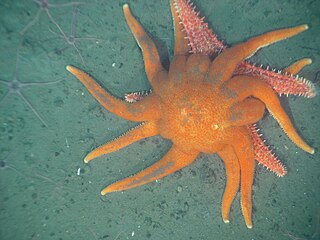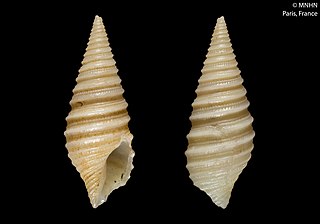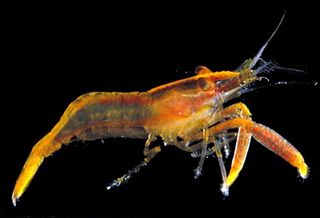
Asterias is a genus of the Asteriidae family of sea stars. It includes several of the best-known species of sea stars, including the (Atlantic) common starfish, Asterias rubens, and the northern Pacific seastar, Asterias amurensis. The genus contains a total of eight species in all. All species have five arms and are native to shallow oceanic areas of cold to temperate parts of the Holarctic. These starfish have planktonic larvae. Asterias amurensis is an invasive species in Australia and can in some years become a pest in the Japanese mariculture industry.

The Valvatida are an order of starfish in the class Asteroidea, which contains 695 species in 172 genera in 17 families.

Patiriella, commonly known as carpet sea star, is a genus of sea stars of the family Asterinidae.

Hippolyte is a genus of shrimp of the family Hippolytidae, containing the following species:

Carcharias is a genus of sand tiger sharks belonging to the family Odontaspididae. Once bearing many prehistoric species, all have gone extinct with the exception of the critically endangered sand tiger shark.

Squilla mantis is a species of mantis shrimp found in shallow coastal areas of the Mediterranean Sea and the Eastern Atlantic Ocean: it is also known as "pacchero" or "canocchia". Its abundance has led to it being the only commercially fished mantis shrimp in the Mediterranean.

Verticordiidae is a family of benthic marine bivalves in the superorder Anomalodesmata. These clams range from 2 - 200 millimeters in length and are mainly found in coastal waters surrounding Australia and the Americas, though a few species within this family such as Haliris mediopacifica are found in the middle of the ocean. Verticordiidae is known for being a family of septibranchs, or predatory bivalves, rather than filter feeders. Clams dig vertical burrows in substrate and use papillae around the edges of their inhalant siphons to detect microscopic prey. Some clams in this family, specifically in the genus Trigonulina, have distinct extended circular formations on their shells.

Members of the genus Metridium, also known as plumose anemones, are sea anemones found mostly in the cooler waters of the northern Pacific and Atlantic oceans. They are characterized by their numerous threadlike tentacles extending from atop a smooth cylindrical column, and can vary from a few centimeters in height up to one meter or more. In larger specimens, the oral disk becomes densely curved and frilly.

Farfantepenaeus is a genus of prawns in the family Penaeidae. Its eight species were formerly included in the genus Penaeus. It was first published as a genus name in 1972 by Rudolf N. Burukovsky, but without the necessary designation of a type species. That situation was corrected by the same author in 1997. The name Farfantepenaeus commemorates the Cuban carcinologist Isabel Pérez Farfante.

Henricia is a large genus of slender-armed sea stars belonging to the family Echinasteridae. It contains about fifty species.

Tomopleura is a genus of sea snails, marine gastropod mollusks in the family Borsoniidae.

Cuapetes is a genus of shrimp in the family Palaemonidae, first described by Austin Hobart Clark in 1919. WoRMS accepts the following species:
Cuapetes elegans is a shrimp species in the genus Cuapetes.

Trachysalambria is a genus of prawns, containing ten species. It was erected in 1934 by Martin Burkenroad, as a subgenus of Trachypenaeus, with T. curvirostris as its type species. That subgenus was elevated to the rank of genus in 1997 by Isabel Pérez Farfante and Brian Kensley. The ten species are:

Farfantepenaeus aztecus is a species of marine penaeid shrimps found around the east coast of the US and Mexico. They are an important commercial species in the US. The FAO refers to them as the northern brown shrimp; other common names, used in the US, are brown shrimp, golden shrimp, red shrimp or redtail shrimp.

Mesopontonia is a genus of shrimp belonging to the palaemoniid subfamily Pontoniinae. It was first described in 1967 by Alexander James Bruce.
Coleusia signata is a species of crab from the family Leucosiidae which is found in the Red Sea and the western Indian Ocean and which has colonised the eastern Mediterranean Sea by Lessepsian migration through the Suez Canal.

Chelonodon patoca, known as the milk-spotted pufferfish or the milkspotted puffer, is a species of pufferfish in the family Tetraodontidae native to the Indo-Pacific. It ranges from East Africa to the Admiralty Islands, New Britain, the Trobriand Islands, China, and northern Australia. It is a tropical species that occurs in coastal waters, lagoons, estuaries, and rivers. While it does enter fresh water, the species does not occur more than a few kilometres from the sea. It is often seen in schools which sometimes enter freshwater streams. It is usually found at a depth range of 4 to 60 m and reaches 38 cm SL. The species is reportedly considered a delicacy in Japan. ITIS lists this species as a member of the genus Chelonodontops, although WoRMS and FishBase both include it within Chelonodon.

Periclimenes carinidactylus is a species of saltwater shrimp found in Australian coastal waters and was first described in 1969 by Alexander James Bruce.
Nikoides danae is a species of crustacean in the family Processidae, first described in 1875 by Otton Mikhailovich Paulson.

















